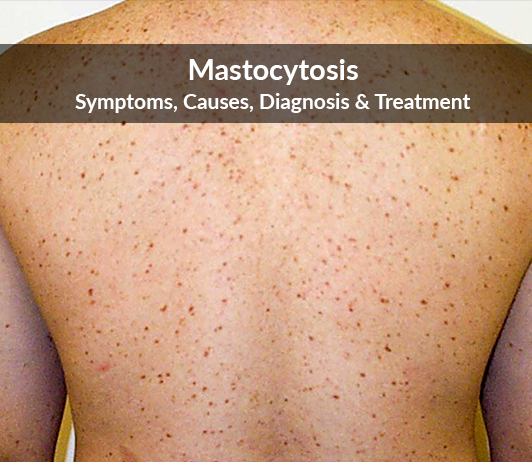Risk factors for anaphylaxis included increased serum tryptase levels and indolent variant of systemic mastocytosis. When mastocytosis affects the skin cutaneous mastocytosis patients may experience.

Mastocytosis Urticaria Pigmentosa Symptoms Causes Diagnosis Treatment
These are some common signs of systematic mastocytosis.

Mastocytosis risk factors. Ad SM can lead to organ damage and shortened overall survival. Drug abuse excessive alcoho consumption preservatives stress sunlight environmental toxins bacteriafungimold artificial colors or flavorings heatcold etc. The study showed a significant incidence of symptoms related to physical factors in patients with mastocytosis and anaphylaxis in history.
Several different risk factors and conditions may predispose to severe life-threatening anaphylaxis. Symptoms may be triggered by cold or heat certain medicines emotional stress and insect bites. Standard pharmacological treatment was ineff.
Moreover proper advice and prescription of adrenaline can be assessed. Patients suffering from mastocytosis and Hymenoptera venom allergy are at risk from a particularly severe sting anaphylaxis. Minimizing your exposure to these triggers may help redcuce you mastocytosis risk.
As the number of oxygen-carrying red blood cells declines patients may develop anemia appearing pale tired or short of breath. The virus is SARS-CoV2. Although many SM patients are suffering from mild or even no mediator-related symptoms others have recurrent episodes of severe anaphylaxis with clear signs of a mast cell activation syndrome MCAS despite.
Systemic mastocytosis SM is one such condition. If you have mastocytosis certain activities and factors can trigger an attack. To determine risk factors study subjects were categorized into 2 groups according to the presence n 55 or absence n 67.
Major perceived trigger factors for adults were hymenoptera stings 19 foods 16 and medication 9. However in 26 of reactions only a combination of different triggers preceded anaphylaxis. How is mastocytosis diagnosed.
If you have any high-risk factors or are immunocompromised due to disease or medications used to treat disease please contact your physician for further instructions. A high extent of skin involvement increased basal serum tryptase values and extensive blistering are risk factors for severe mast cell activation episodes in children whereas these associations seem to be less strong or nonexistent for anaphylaxis and osteoporosis in adult patients with indolent systemic mastocytosis. There is no need to perform skin tests in patients with mastocytosis prior to an anesthetic.
However all patients with prior uninvestigated perioperative immediate hypersensitivity should undergo skin tests with the medications that could have potentially. Trigger factors remained unidentified in 67. Treatment with tyrosine kinase inhibitors including dasatinib Sprycel midostaurin PKC412 recently approved by the FDA for the treatment of systemic mastocytosis and less commonly imatinib Gleevec and nilotinib Tasigna may be considered for patients.
Allergic reaction that causes low blood pressure hives itching flushed or pale skin and swelling in the tongue or throat that can make it hard to breathe. Risk factors concerning COVID-19induced morbidity and mortality include advanced age an impaired immune system cardiovascular or pulmonary diseases obesity diabetes mellitus and cancer treated with chemotherapy. A cross-sectional study was conducted in 122 consecutive adult patients with SM admitted to the Mastocytosis Center at Karolinska University Hospital.
All patients underwent medical evaluation including bone marrow biopsy and a thorough allergy workup. Some of the things that trigger the release of histamine from mast cells also cause the symptoms of mastocytosis. The disease is termed COVID-19 infection results from.
38 rows Many people affected by mastocytosis especially systemic. For mastocytosis the target is the unique protein called the c-kit tyrosine kinase receptor see the Risk Factors section. An early diagnosis of CMD in these patients is very important since they are at high risk of severe osteoporosis and early therapy can be immediately started.
A high extent of skin involvement increased basal serum tryptase values and extensive blistering are risk factors for severe mast cell activation episodes in children whereas these associations seem to be less strong or nonexistent for anaphylaxis and osteoporosis in adult patients with indolent systemic mastocytosis. Ad Largest Online Market Research Store. Up to 10 cash back ConclusionsMastocytosis represents a risk factor for severe reaction in patients with HVA.
Learn more about smoldering indolent and advanced forms of SM. A recent study Risk Factor Analysis of Anaphylactic Reactions in Patients with Systemic Mastocytosis SM by Theo Gülen et al was conducted on 122 patients with SM at the Karolinska University Hospital in Sweden. Browse The Largest Database Of Market Research Reports And Industry Analysis.
In most cases it is not inherited passed down from one generation to another. Mastocytosis in particular systemic mastocytosis is often caused by a mutation a change in the code or sequence in a gene called KIT. Standard pharmacological treat- Klinika Alergologii Gdański Uniwersytet Medyczny ment was ineffective in 10 of the patients who may require biological treatment.
They need optimal diagnosis and treatment. Skin rashes itching hives or flushing of the skin. However the triggers arent the same in every person.
Abdominal pain diarrhea nausea or vomiting. Here we discuss the risk and impact of COVID-19 in patients with mastocytosis and mast cell activation syndromes. The change happens after conception.
The following triggers may influence a mast cell response. A high extent of skin involvement increased basal serum tryptase values and extensive blistering are risk factors for severe mast cell activation episodes in children whereas these associations. While there is not yet complete data it appears acute lung injury caused by SARS-CoV note.
Risk factors for anaphylaxis included increased Marek Niedoszytko MD PhD serum tryptase levels and indolent variant of systemic mastocytosis. Trusted By Over 400 Of The Fortune 500. Chemicals released by mast cells can also lead to typical allergic responses such as flushing itching abdominal cramping muscle pain and even shock.
To determine risk factors patients were categorized into two groups 55 who had anaphylaxis and 67 who did not. 911 Mastocytosis itself is not a risk factor for perioperative drug- or latex-induced IgE-mediated allergic hypersensitivity.

Mast Cell Disorders From Infancy To Maturity Wilcock 2019 Allergy Wiley Online Library
Tidak ada komentar